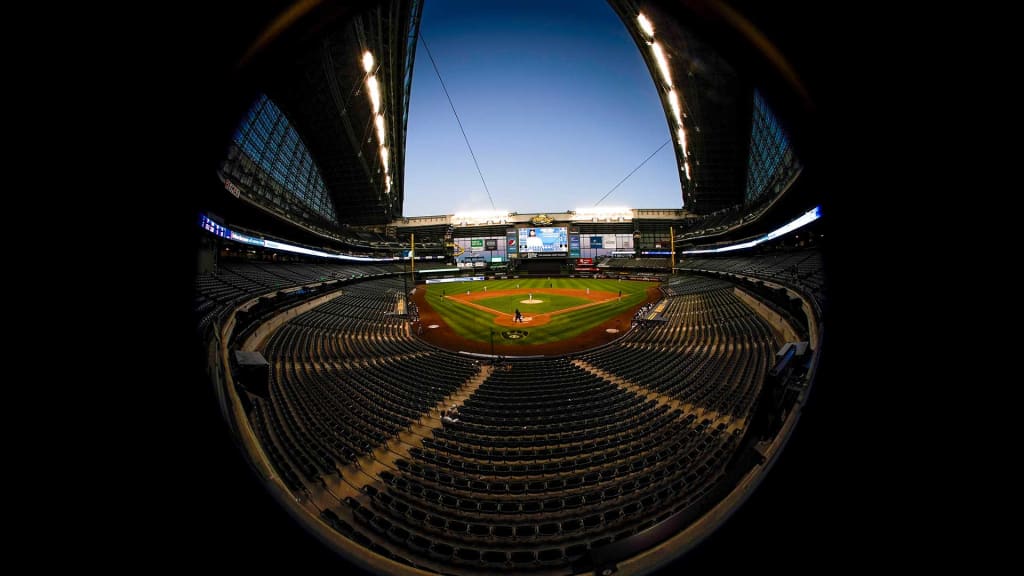
MILWAUKEE -- Did you ever wonder how the Brewers decide whether the roof is open or closed for the first pitch of a ballgame?
Few elements of the fan experience at American Family Field -- known as Miller Park from its grand opening in 2001 through the end of 2020 -- generate as much scrutiny as the position of the stadium’s fan-shaped roof. It weighs 12,000 tons, covers more than 10 acres, can open or close in less than 15 minutes, and is such a hot topic on gamedays during Wisconsin’s fickle spring and fall that there’s a hotline offering a recorded message helping fans plan their wardrobe. Open roof or closed?
Whether a game begins with the roof open or closed is solely up to the Brewers. So, how do they decide? It’s a combination of factors led by the temperature and the weather forecast.
But with 40,000-plus guests in attendance, many with strong opinions on the matter, there’s as much art as science some days.
“Fan comfort drives it, frankly,” said Steve Ethier in 2020, when he was the Brewers’ senior vice president of stadium operations. “And our desire is to keep it open as much as we can.”
On a dry day, Ethier said, 63 degrees is the rough threshold for having an open roof while providing a comfortable environment for fans -- especially those sitting out of the sunlight. If it’s clear that the temperature will dip below 63 degrees during the game, the Brewers typically err on the side of beginning the game with the roof closed, he said.
But it’s more complicated than checking the thermometer, Ethier said.
“Sixty-three degrees in April when [Lake Michigan] is still cold is very different from 63 degrees in September,” Either said. “Sixty-three in April when there is any kind of breeze off the lake can feel awfully cold. In September, 60 degrees could be just fine.”
Then there’s the matter of the weather forecast. It’s about more than rain, since the roof has built-in limit switches that restrict movement when wind speed reaches a certain level. For example, say it’s a sunny spring day with temperatures in the mid-60s for batting practice, but the forecast calls for a front to move through sometime after the first pitch. Because of wind considerations, the Brewers may opt to close the roof for the start of the game to avoid being stuck open during a spot rainstorm in the third inning.
Once the first pitch is thrown, Major League Baseball rules govern what can happen next. Those guidelines are laid out in the Brewers' media guide.
If the game begins with the roof open:
• It shall be closed only in the event of impending rain or other adverse weather conditions. The decision to close the roof shall be made by the home club after consultation with the Umpire Crew Chief.
• The Umpire Crew Chief shall notify the visiting club, which may challenge the closing of the roof if it feels that a competitive imbalance will arise. In such an event, the Umpire Crew Chief shall make a final decision based on the merits of the challenge.
• The roof may be re-opened by following the procedures for opening the roof as detailed below.
If the game begins with the roof closed:
• It may be opened when, in the opinion of the home club, the climatic environment has reached a level where fan comfort and enjoyment will be best served by opening the roof to the natural atmospheric conditions.
• Notwithstanding the foregoing, the following guidelines should be applied when opening the roof during a game:
-- The roof may be opened only once during the game.
-- The Umpire Crew Chief will be notified at the commencement of the inning that the roof will be opened at the inning’s conclusion.
-- The Umpire Crew Chief shall notify the visiting club, which may challenge the opening of the roof if it feels that a competitive imbalance will arise. In such an event, the Umpire Crew Chief shall make a final decision based on the merits of the challenge.
-- The roof may only be opened between innings.
As Ethier said, the desire is to keep the roof open as much as possible. Besides enjoying nice Wisconsin weather when it’s available, the airflow from an open roof is actually good for the health and growth of the playing surface, according to Ethier, and the sunlight is obviously good as well.
Everyone can agree that the roof has been a good thing for the Brewers, who get to play half their schedule without the threat of a rainout. But whether it’s open or closed on a given gameday will remain a matter for healthy debate.
“It’s a lot like your thermostat at home,” he said. “You might feel good when it’s set at 68, but someone else may not. It can be very subjective. It’s an area where you’re trying to please as many people as you can.”
MLB.com is starting a new series of stories seeking to answer some of the common questions about teams’ traditions, stadiums, players and history -- the sorts of things that might begin at a pregame tailgate with someone asking, “Did you ever wonder …” Look for more entries in the coming weeks, and if you have a question that needs answering, feel free to submit it via one of the links in the tagline below.
